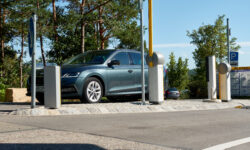A New Age: Digital Electricity
While DE is still in its early stages of development, it’s clear that it has the potential to transform the way that we generate, transmit and distribute electricity.

The Circa Resort & Casino in Las Vegas uses digital electricity: Spanning 1.25 million square feet, with 777 rooms and suites, the Circa capitalizes on cutting-edge tech including advanced building automation, digital in-room controls, LED lighting, and electrical power distribution, utilizing digital electricity from VoltServer, to power its critical electrical infrastructure. Image: The Circa Resort & Casino.
Most of us in the low-voltage industry are familiar with the National Electrical Code (NEC, a.k.a. NFPA 70) and its reference to Class 2 cabling standards. Did you know, however, that there is a new kid on the block that’s coming out with the latest edition of NEC 2023? It is Class 4 and has to do with something called digital electricity.
Digital electricity (DE) is a relatively new concept that’s gaining traction in the energy industry. Unlike traditional electricity, which is generated, transmitted and distributed as an analog signal, digital electricity is generated, transmitted and distributed as a digital signal. This means that it can be controlled and managed more efficiently and effectively than analog electricity.
How It Works
Digital electricity is a patented technology invented by a company called VoltServer. By using digital signals to control the flow of electricity, it’s possible to achieve much greater efficiency and precision than with analog signals. Entire office buildings and factories are now being wired with the VoltServer systems. If you are capable of working with category cabling, then you can work with DE.
In essence, digital electricity is a new way of controlling the flow of energy. It is based on the same principles as digital communication, where data is transmitted using binary signals. In the case of digital electricity, these signals control the flow of electrical current by utilizing pulse width modulation (PWM), which involves switching the power on and off at 500 times per second. This allows the power to be delivered in precise, controlled bursts, rather than a continuous flow.
A DE system starts out with input from conventional AC power. A head end transmitter in the system converts the AC to DC and transmits supervised micro-burst DC pulses along the special category cabling. This waveform can be adjusted to optimize the power output for a particular application, making it more efficient than traditional analog electricity. While existing systems like PoE can handle up to 90 watts, a digital electricity system can handle up to 2,000 watts on 18-gauge category cable for a distance of 2,000 meters.
Belden manufactures a special cable for DE systems which can also include fiber cabling. The DE control units, transmitters and receivers, will instantly shut down the circuit if a faulty condition occurs. Even though it uses high-voltage pulses, some have said that a shock feels like a pin prick. Because of the safety requirements in the DE system controls, low-voltage Class 2 practices can be applied. No conduit is needed because the cabling is handled like any other category cabling.
At the end of the digital power network, the digital electricity is distributed to the end user. This can be done using digital power outlets, designed to receive digital signals instead of analog signals. The digital power outlets can be programmed to provide a precise level of power output, making them more efficient than analog power outlets.
Exploring DE’s Benefits
Digital electricity offers several potential benefits. One of the main advantages is that it’s more efficient than traditional analog electricity. This is because it allows for precise control of the flow of electricity, which can be adjusted to optimize the power output for a particular application. This can lead to significant energy savings, especially in applications where the power demand varies over time.
DE is also more reliable than traditional analog electricity, because it’s less susceptible to interference from other electrical equipment. The digital power lines are insulated to prevent interference, and the digital signals are transmitted with greater accuracy than analog signals. This can help to reduce downtime and improve the overall reliability of the power supply.
Another potential benefit of DE: It’s more flexible than traditional analog electricity, because it can be programmed to provide a precise level of power output for a particular application. This can be useful in applications where the power demand varies over time, or where different levels of power output are required for different devices.
Digital electricity is a new concept that has the potential to revolutionize the energy industry. While DE is still in its early stages of development, it’s clear that it has the potential to transform the way that we generate, transmit and distribute electricity in the future. This is a new and exciting opportunity for low-voltage integrators looking for new markets.
If you enjoyed this article and want to receive more valuable industry content like this, click here to sign up for our FREE digital newsletters!

Security Is Our Business, Too
For professionals who recommend, buy and install all types of electronic security equipment, a free subscription to Commercial Integrator + Security Sales & Integration is like having a consultant on call. You’ll find an ideal balance of technology and business coverage, with installation tips and techniques for products and updates on how to add to your bottom line.
A FREE subscription to the top resource for security and integration industry will prove to be invaluable.








